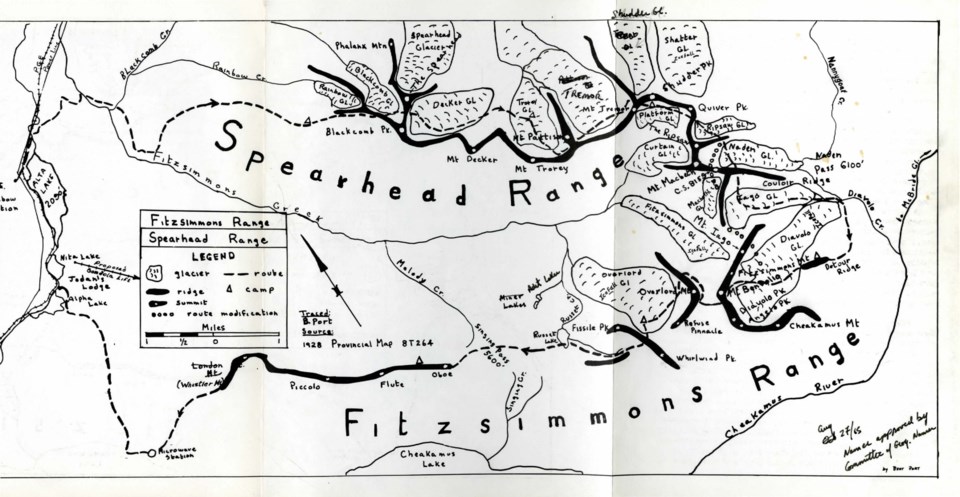The Spearhead Traverse, which links Whistler and Blackcomb via a horseshoe-shaped route that takes participants across the peaks of the Spearhead Range, is one of the most popular trips for backcountry ski-touring today.
While the route is now completed routinely by hundreds of participants, it was pioneered in May of 1964 by members of the University of British Columbia’s Varsity Outdoor Club (VOC). The first recorded mountaineering attempts in the Spearhead occurred as early as 1923, and the British Columbia Mountaineering Club expedition, led by Neal Carter, made many of the first recorded ascents of the Garibaldi region in 1925. The VOC’s 1964 expedition across the traverse hoped to make up for an earlier attempt by the club in 1954 that was called off due to inclement weather.
In 1964, VOC members Alistair MacDonald, Karl Ricker, Bert Port and Chris Gardner were drawn to the Spearhead Traverse for a variety of reasons. They had acquired plenty of information from other mountaineering efforts in the region concerning both Blackcomb and Whistler mountains, which would bookend their route. Additionally, proposed skiing development on Whistler Mountain and the prospect of a new VOC cabin in the region prompted the group to investigate potential backcountry ski-touring routes.
The party of four, equipped with ski-touring gear, 10 days’ worth of food and a hunger for adventure, caught the train up to Rainbow Station and proceeded to make their way into the treeline of Blackcomb Mountain, the most westerly point of the range. Here, they established their first camp, christening it “Bonfire Camp,” knowing that this was likely the last opportunity to have the luxury of an evening bonfire. Their journey began in earnest the day after, setting off from the treeline to get within striking distance of the summits of both Blackcomb Mountain and the neighbouring Spearhead Mountain. After bagging both Blackcomb and Spearhead, the party was able to descend and begin the journey across the Decker Glacier in the shadow of Decker Mountain before concluding their day on Trorey Glacier and establishing “Cannonball Camp,” so named for the snowballs that rolled through the campsite while they slept.
The third day brought bad weather, forcing the group to halt progress while providing ample opportunities to make equipment repairs. The weather let up by the fourth day, sending the party towards both Mount Trorey and Mount Pattison. At this point, the group came up with a unique strategy in order to complete more ascents: by splitting into two, they could separate at the col (the lowest point between two mountain peaks) in order to climb adjacent peaks. In this manner, they were able to summit both Trorey and Pattison before reconvening for lunch at their previous campsite and then crossing onto Tremor Glacier. The group then circumnavigated the north side of Mount Tremor and scrambled up to the col between it and Mount Shudder, hacking the ice and snow in order to make room for two tent platforms and establishing “Platform Camp.” At the end of the fourth day, the party was approaching the head of the valley, which would mark the midpoint of their journey.
Check back next week for Part 2.




